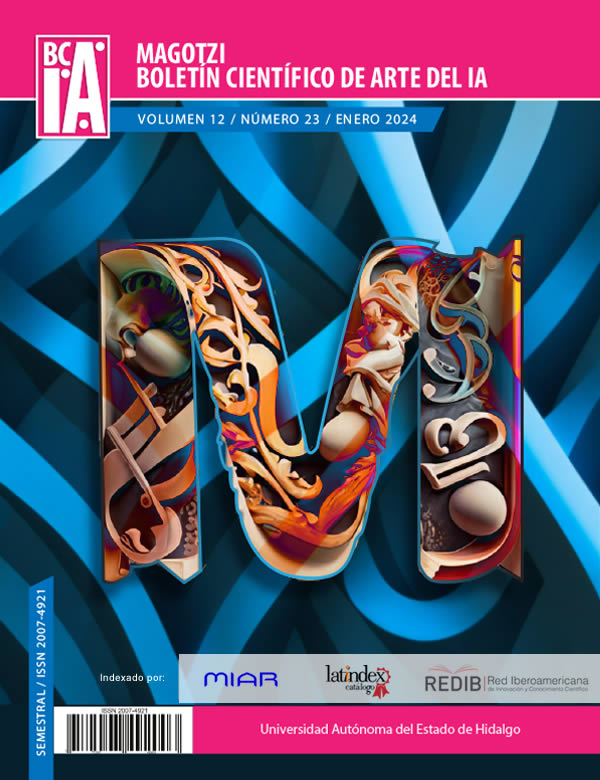The B-Learning modality implemented for learning an Engraving Workshop during confinement due to the COVID-19 pandemic: advantages and disadvantages
Abstract
Due to the COVID-19 pandemic, on March 16, 2020, the Ministry of Health of the Government of Mexico implemented the National Day of Healthy Distance, which resulted in the closure of public spaces, the suspension of activities, the rethinking of the academic calendar and school activities. To prevent and stop the level of contagion in educational settings, the Ministry of Public Education considered implementing the virtual modality at the national level for basic and secondary education and higher education centers, such is the case of the Institute of Arts (IA) from the Autonomous University of the State of Hidalgo (UAEH). Within this framework, the objective of this document is to analyze, through a qualitative approach, the advantages and disadvantages of the B-Learning modality for the teaching-learning technique of linocut and xylography —wooden engraving— to the students of the second semester of the degree in Visual Arts of that house of studies; likewise, they will reflect on the learning strategies and methods that the students applied to complement their professional training during confinement. The research is also descriptive in nature and points out cultural, economic and social aspects, and their implications for the engraving workshop, where these techniques are taught, and the vicissitudes that occurred in the context of the pandemic. The collection of information was carried out by observing the teacher during the virtual sessions. The work is divided into five parts, which are: 1) Methodology, 2) B-Learning Model, 3) Application of the method, 4) Advantages and disadvantages, 5) Discussion.
Downloads
References
Bautista, G; Borges, Federico y Forés Anna. (2006). Didáctica universitaria en Entornos Virtuales de Enseñaza-Aprendizaje. Madrid: NARCEA.
Contreras Bravo, L. E; González Guerrero, K. y Fuentes López, H. J. (2011). Uso de las TIC y especialmente del blended learning en la enseñanza universitaria. Revista Educación y Desarrollo Social, 5(1), 151-160. https://dialnet.unirioja.es/servlet/articulo?codigo=5386251
Aguilar-Gordón, F. (2020). Del aprendizaje en escenarios presenciales al aprendizaje virtual en tiempos de pandemia. Estudios pedagógicos, 46(3), pp. 213-223. https://dx.doi.org/10.4067/S0718-07052020000300213
García Aretio, L.; Ruíz Corbella, M. & Domínguez Figaredo, D. (2006). De la educación a distancia a la educación virtual. Barcelona: Ariel.
González Aldana, M. A.; Perdomo Osori, K. V. y Pascuas Rengifo, Y. (2017). Aplicación de las TIC en modelos educativos blended learning: Una revisión sistemática de literatura. Sophia, 13(1), 144-154. http://dx.doi.org/10.18634/sophiaj.13v.1i.364
Pianowski, F. (2018). Arte en red: la estructura del mail art. Revista Lindes-Estudios Sociales del Arte y de la Cultura-Prop. Int. y Dir.: Claudio Lobeto/ISSN, 1853, 5798.
Rojas Cuevas, R. M. (2012). Programa del Taller de Introducción IAB (GRABADO). Pachuca de Soto, Hidalgo, México: Universidad Autónoma del Estado de Hidalgo.
Universidad Autónoma del Estado de Hidalgo. (2004). Dimensión Pedagógica del Modelo Educativo. https://www.uaeh.edu.mx/modelo_educativo/docs/triptico_final_corregido.pdf
Universidad Autónoma del Estado de Hidalgo. (2020). Propuestas de Reglas de operación para Programas Educativos Bachillerato y Licenciatura en modalidad B-Learning. Pachuca de Soto, Hidalgo, México: Universidad Autónoma del Estado de Hidalgo.
Copyright (c) 2023 Rosa Maribel Rojas Cuevas, Celia Guadalupe Morales González, Gisela Ivonne Cázares Cerda

This work is licensed under a Creative Commons Attribution-NonCommercial-NoDerivatives 4.0 International License.











